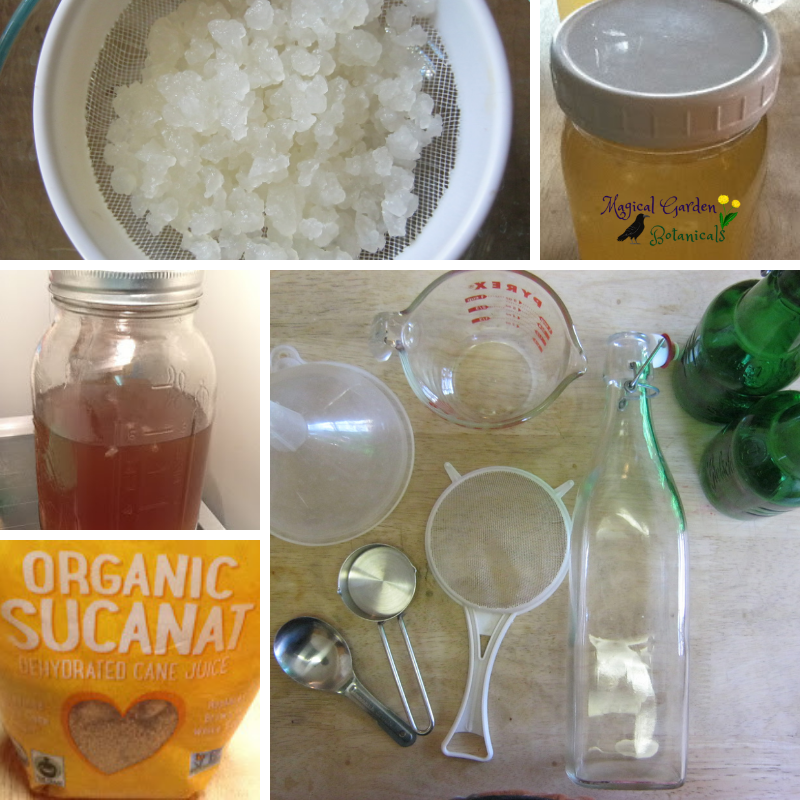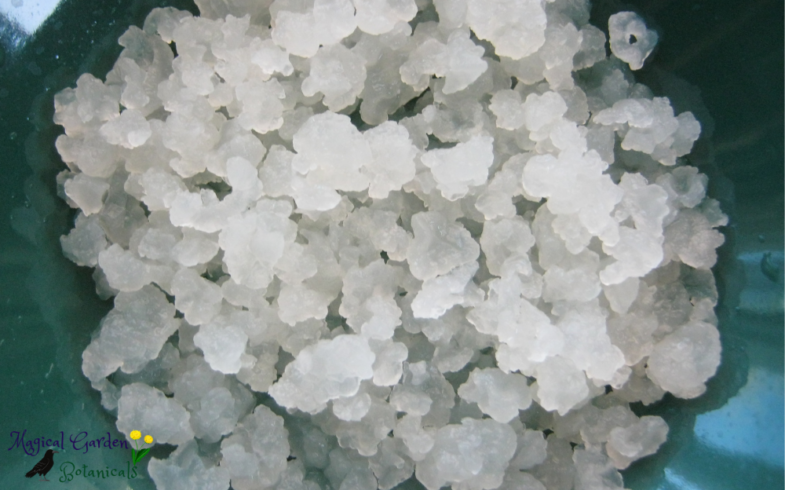Drink your probiotics!
Water kefir is a probiotic drink that is made with sugar, water, and kefir grains. In this case, these grains don’t have anything to do with wheat or similar plants. Rather they are composed of beneficial bacteria and yeast. These grains are also not the same as dairy kefir grains. Water kefir grains feed off of sugar, so very little sugar is actually left in the finished product. The resulting product is a slightly sweet, fermented drink that contains immune boosting probiotics.
Some of the benefits of the probiotics found in kefir water include: boosts immunity, beneficial in healing digestive issues, may help to mitigate some of the negative effects of EMF’s (electromagnetic fields), and supports detoxification. Studies are also being done to learn about the positive effects of probiotics on certain mental health conditions such as anxiety and depression.
So what are probiotics? Beneficial bacteria! Sounds gross? Not really, considering our bodies are teeming with all sorts of bacteria, beneficial and not beneficial. Some refer to this as the gut microbiome. When we consume a diet that is balanced and full of probiotic enhancing foods we nourish the “good bacteria”. However, many factors like stress, poor diet (processed foods), and some medications (especially antibiotics) may increase the growth of “bad bacteria”. This is when we begin to have symptoms that may indicate we are out of balance. So how do we replenish the beneficial bacteria? We begin by addressing the causes of the imbalance. To start, reduce the sources of bad bacteria and increase the beneficial bacteria. Also, adding prebiotic foods to the diet is extremely helpful. Prebiotics help to feed the probiotic bacteria. They are a non-digestible type of fiber called oligosaccharides. Once consumed they make their way to the large intestine to where they are fermented by anaerobic bacteria. Some foods considered prebiotic include: raw or cooked onions, raw garlic, dandelion greens, jicama, Jerusalem artichokes, raw asparagus, raw chicory root, under-ripe bananas, oats, apples, burdock, flax seeds, avocado, peas, apple cider vinegar, and almonds.
There’s a multitude of ideas on the correct or best way to make kefir water. I have tried several methods, some with great results and others, quite disastrous. I am going to share what worked for me. It was quite a bit of trial and error. So with that, know that the method I am going to share isn’t “the only way”. Perhaps you can take some or all of my ideas and apply them to your own experience.
There are quite a few factors to consider while dialing in what works for you. These are consistent indoor temperature, water quality, fermentation time, and types of sugars used. Be sure to keep all utensils and containers clean. Wash jars thoroughly in-between uses. I also recommend beginning with hydrated grains. In my experience, dehydrated grains did not give consistent results.
Supplies needed include:
- funnel
- measuring spoons and/or cups
- fine mesh strainer
- glass jar with lid
- flip-top bottle for second ferment (glass or ceramic)
Ingredients:
- water kefir grains
- filtered water
- organic cane sugar
- organic sucanat (dehydrated cane juice)
- juice for the second ferment
If the grains are already hydrated then you are ready to begin making water kefir. All measurements given are for a quart, adjust accordingly for larger or smaller amounts. You will need the following ratio: 1 cup water/1 tablespoon sugar/1 tablespoon grains. For a 1 quart mason jar that comes out to 32 oz. water, 4 tablespoons sugar, and 4 tablespoons water kefir grains. Please note that these measurements will not fit into a quart jar, so use a larger container or decrease the amount of water.
Please use only glass or plastic when working with the grains, although stainless steel is ok for stirring and straining the grains. Other metals and stainless steel are not recommended for fermenting or storing the grains. Since the grains are of an acidic nature, they have the possibility of causing the metal to leach over time. A metal lid is ok if it doesn’t come into contact with the liquid. I prefer to use glass for fermenting and storing the grains due to the fact that plastic has the potential to leach chemicals.
Water quality is an important factor in the success of maintaining the grains. I use water from my Berkey that has the added fluoride filter. I do not use my water ionizer (Kangen water machine), even on the clean water setting. Do not use tap water, use only filtered or spring water.
During the first ferment, place the lid loosely on the jar. Do not tighten. Begin by dissolving the sugar into the water. In a 1/4 measuring cup, add about 1 teaspoon sucanat and the rest cane sugar. Please use only organic sugars as you want to avoid adding chemicals to your water kefir. Once the sugar is dissolved, add the grains. Place the lid loosely on the jar, you should be able to turn it without any resistance. I use a plastic lid for this, however, a coffee filter with a rubber band can be used also. I have had more success placing a lid loosely on the jar, thus allowing less air into the jar. Allow the jar to sit on a countertop in a draft free area that is out of direct sunlight. Also, make sure the area is not subject to drastic temperature changes. Allow to ferment 24 to 48 hours. I usually leave mine 24 hours, the longer you leave it, the less sweet it will be. It also depends on how warm the room is, a warmer room makes it ferment faster.
Since I always do a second ferment on water kefir, I just strain the liquid directly into the flip-top bottle. After 24 hours (or 48 hours) the water kefir is ready. This is called the first ferment. Strain the grains and the resulting liquid is water kefir. Set aside the strained liquid. The water kefir can be used as-is or flavored. Store in the refrigerator in a closed container. Repeat the process of making the sugar water and adding the grains. If you would like a carbonated drink instead, then do the second ferment.
If you are planning on doing a second ferment, then pour the strained liquid into a flip-top bottle. Now it’s time to flavor the kefir. For citrus juices add 1/4 cup, for other juices, add 1/2 cup. Experiment with flavorings such as vanilla beans, vanilla extract, dried fruits, and other types of extracts.
Allow the second ferment in the flip-top bottle to ferment 24 hours. As with the first ferment, keep it on a countertop in a draft-free area that is out of direct sunlight. A word of caution-this will create carbonation so be careful when opening the bottles. If it has been more than 24 hours, or in warmer temperatures, be sure to burp the bottles to release excess pressure. I have had bottles explode late at night during the summertime when I forgot to refrigerate them…no fun at all! When the fermentation is complete, store it in the refrigerator.
A note about the kefir grains, under correct conditions, they will multiply. Excess grains can be saved, shared, eaten, or even composted. Please don’t toss these hard working little bits of goodness! I add them to smoothies and feed them to my pets. Animals need assistance sometimes with their gut health and this is a great way to do that. Kefir grains work wonders on gassy doggies! To save the grains, simply refrigerate them in a sugar water solution in a lidded jar. The ratios are not the same as they are for making the kefir water. The jar pictured is a 64 oz jar. It has roughly 2.5 cups of kefir grains. I added about a half cup of sucanat and the rest is water. About once a week or every other week, I will strain the kefir grains and add fresh sugar water. The grains become semi-dormant in the refrigerator, so this is a great way to store them.
Water kefir is a delicious and low-cost way to increase the amount of probiotics in the diet. It is also versatile with many flavoring options. Water kefir that has gone through a second ferment makes a great alternative to sugary soft drinks. If you haven’t tasted water kefir yet, I hope this inspires you to give it a try.

Resources:
Kefir and health: a contemporary perspective
Probiotics-have-a-positive-effect-on-stress-and-anxiety-

Daughter of the Earth, Mother of her creations. Ivanna (Evie) doesn’t care for titles, but the ones that fit best are homeschool mom, herbalist, and blogger. Her greatest joy is guiding others to find true wellness within themselves and Mother Earth. When not spending time with her beloved family, she can be found researching everything related to holistic wellness, crafting herbal remedies, or visiting with the plants in the Magical Garden.




